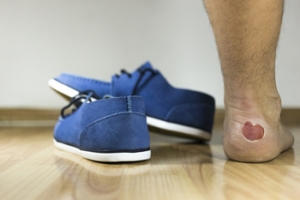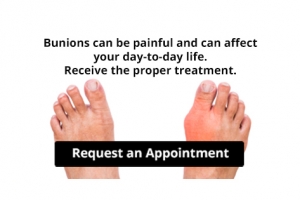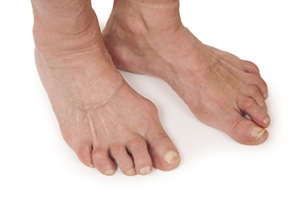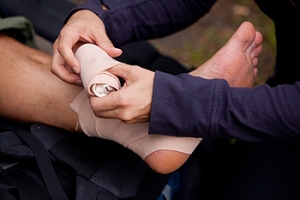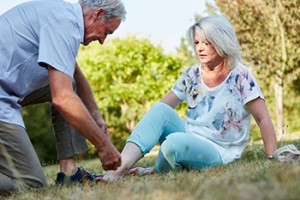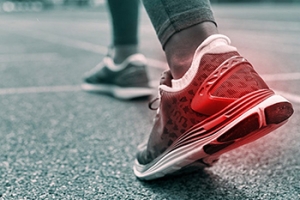Super User
How Did I Get a Blister on My Foot?
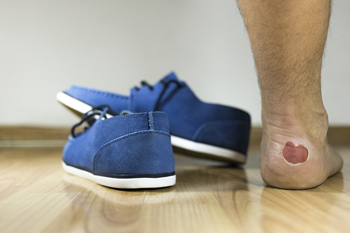
The majority of blisters that develop on the feet are not serious, despite the discomfort they can cause. A blister appears as a small bubble that forms over damaged skin. It is filled with liquid that protects the skin as it heals, allowing new skin to form. A blister is the body’s natural defense to protect raw skin, and will gradually drain when the new skin has developed. A blister generally occurs as a result of excess friction that can be caused by wearing shoes and socks that do not fit correctly. A blister may also form as an allergic reaction to an insect bite, or if the skin has been burned by fire or chemicals. Additionally, people who have been exposed to extreme cold temperatures may develop blisters as a natural method of keeping heat in the body. Many people choose to put a protective covering over the blister, which may help prevent it from popping or draining prematurely. If you would like more information about prevention techniques for blisters on the feet, it is suggested that you speak with a chiropodist who can provide you with useful tips.
Blisters can usually be treated at home, however, if you have recurring blisters or experience significant discomfort or pain, please consult with one of the chiropodists from The Footcare Centre. Our chiropodists will assess your condition and provide you with quality foot and ankle treatment.
What Is a Blister?
A blister is a small pocket of fluid in the upper skin layers and is one of the body’s natural responses to injury or pressure. Blisters can also result from burns, fungal or viral skin infections, and the feet are particularly prone due to ill-fitting footwear and friction. Friction on the skin causes the upper layer of skin to separate from the lower layers. The space that this separation creates then becomes filled with a liquid called serum, which protects the lower layers of skin.
Treatment
If you notice a blister on your foot, you can cover it with a soft bandage or dressing to protect it. Popping the blister is discouraged. Doing so exposes the raw skin underneath it to bacteria and also raises the risk of infection. If a blister pops naturally, let it drain before covering it with a bandage. Blisters usually heal on their own or with home treatment, however, if your blister is recurring, very painful, or appears infected, it is recommended that you see a chiropodist for treatment.
Prevention
You can help to prevent blisters by wearing comfortable, well-fitted shoes. Keep your feet dry by wearing moisture-wicking socks and dust your feet with talcum powder if they tend to get sweaty. If you have areas on your feet that are more susceptible to blisters, you might be able to prevent the blister from forming by covering it with a pad.
If you have any questions, please feel free to contact our office located in . We offer the newest diagnostic and treatment technologies for all your foot care needs.
Blisters
Blisters are fluid-filled bubbles of skin that can appear on any part of the body and are particularly common on the feet. Most foot blisters form due to friction. As you walk, run, or go about your daily activities, your shoes may rub against specific areas of your feet, causing the skin to become damaged. The top layer of skin then separates from the lower layers of skin. The area between the separated layers fills with a fluid called serum, whose purpose is to cushion and protect the raw skin below the blister.
If you find a friction blister on your foot, it is highly recommended that you do not pop it. Popping the blister drains the fluid inside of it and exposes the raw skin underneath, increasing your risk of infection. Instead, protect the blister by loosely covering it with a bandage. You can also use special padding around the blister to protect it. Typically, friction blisters naturally heal over the course of one to two weeks. Friction blisters can be prevented by wearing well-fitted shoes and moisture-wicking socks. Wearing soft bandages over areas of your foot that tend to blister may also help.
Sometimes foot blisters can be caused by problems other than friction. Blisters can develop due to a sunburn, frostbite, or exposure to an allergen, as well as from medical conditions such as fungal infections or eczema. If you frequently find blisters on your feet, it is recommended that you consult with a podiatrist.
Are Bunions Affecting Your Everyday Life?
How Rheumatoid Arthritis Can Affect the Feet
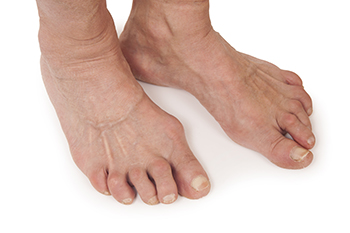
Rheumatoid arthritis, or RA, is an autoimmune condition where the immune system tries to destroy the linings of the joints, known as synovium, or the fluid in the joints called synovial fluid. The body mistakes these areas as disease invaders. Most people who are afflicted with rheumatoid arthritis develop symptoms in their feet. In fact, inflammation and pain in the feet are often one of the first signs an individual can have with RA. With rheumatoid arthritis, there can be pain in the joints, which may be accompanied by constant aching. Symptoms of this condition may often become worse after prolonged standing, walking, or running. With RA, a patient can experience swelling and stiffness, especially in the morning. The long-term inflammation thickens the synovium, which erodes cartilage and bone. The joints may look deformed, and wearing shoes may be challenging. The different types of foot problems associated with RA are heel pain, swelling of the nerves, and skin rashes. Rheumatoid nodules or lumps may develop under the skin. If you have rheumatoid arthritis and are experiencing foot pain, it is strongly suggested that you visit with a chiropodist as soon as possible who can help in providing relief and possibly prevent progression of this disease.
Rheumatoid arthritis (RA) is an autoimmune disorder in which the body’s immune system attacks its own otherwise healthy joint lining or synovium. While RA can affect any joint in the body, it often affects the small joints of the feet and the ankle joint. If you’re dealing with RA in your lower limbs, please consult with one of the chiropodists from The Footcare Centre. Our chiropodists can help you maintain the health of your lower limbs and your mobility.
Symptoms of RA primarily affect the joints of the feet and may include:
Pain
Swelling
Stiffness
Redness
Warmth
Difficulty walking
Gait changes
Bunions
Hammertoes
Treatment
While there is no cure for RA, your chiropodist can help you manage the health of your feet and maintain your mobility while living with this condition. Possible treatments include wearing orthotics, doing foot and ankle exercises, resting the feet, taking anti-inflammatory medications, getting steroid injections, and wearing braces for foot and ankle pain. In advanced cases of RA, joint replacement surgery may be helpful for mobility. Bunions, hammertoes, and other deformities can be corrected with surgery as well.
If you have RA, please feel free to contact our office located in . We offer the newest diagnostic and treatment technologies for all your foot care needs.
Rheumatoid Arthritis
Rheumatoid arthritis (RA) is an autoimmune disorder in which the body’s immune system attacks its own otherwise healthy joint lining. This condition can affect any of the 33 joints of the feet, as well as the ankle joints. RA symptoms include joint pain, stiffness, swelling, and warmth. It may become difficult to stand, walk, or exercise due to joint pain. RA can also affect the biomechanics of the feet. When the structure of the foot changes, this can affect one’s gait or walking pattern. Foot deformities, such as bunions and hammertoes, also become more likely. RA’s negative effects on mobility could impact one’s overall quality of life.
Although there is no cure for RA, your chiropodist can help you manage symptoms and maintain the health of your feet and your mobility. They may recommend conservative treatments such as resting and icing the feet and taking non-steroidal anti-inflammatory medications to manage pain. Orthotic inserts and braces can help reduce pain and give the feet structure and support. In more severe cases, corticosteroid injections can be used to relieve pain as well.
Surgical treatments for joint pain are another possible option for those with RA, particularly if the conservative treatment methods described above prove ineffective. Joint fusion surgery or joint replacement surgery may help. Deformities like bunions and hammertoes can be surgically corrected as well.
To learn more about living with RA, please consult with a chiropodist near you.
Dealing With Sprains and Strains
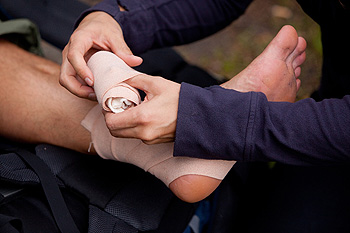
Many people who are involved in sports are familiar with injuries caused by sprains and strains. Sprains are caused by the tearing or rupture of a ligament. Strains are caused by a tearing or rupture of a muscle or tendon. Signs that you may have a sprain or strain include pain, tenderness, or weakness in the foot, ankle, or toe joints, as well as bruising and swelling. Muscle cramps or spasms may indicate a strain. If bearing weight causes pain or inhibits daily activities, a sprain or strain may be the cause. To help prevent sprains and strains it is a good idea to warm up before and cool down after exercising with stretches. Wearing shoes that fit properly and provide ample support and cushioning is a good way to prevent injury. If the pain from a sprain or strain does not diminish after following a course of rest, ice, compression, and elevation, it is suggested that you make an appointment with a chiropodist. This foot specialist can thoroughly examine the site of the injury and determine further treatment options.
Injuries to the foot and ankle are very common among athletes. If you have experienced an injury, please consult with one of the chiropodists from The Footcare Centre. Our chiropodists will assess your condition and provide you with quality foot and ankle treatment.
Common Injuries Among Athletes:
Achilles tendon injuries
Ankle strains or sprains
Plantar fasciitis
Fractures
Turf toe
Joint dislocations
Sever’s disease
Morton’s neuroma
Symptoms
Symptoms will depend on the cause and severity of the injury. Common symptoms for a foot or ankle injury include pain, swelling, tenderness, bruising, a reduced range of motion, and difficulty bearing weight or walking on the affected foot or ankle.
Diagnosis
Sports injuries are typically diagnosed after carefully examining the affected foot or ankle. This includes moving the injured area to test its range of motion. Medical history will need to be provided, as well as detailed information about how the injury occurred. Imaging studies, such as X-rays or MRIs, may be used to confirm or rule out certain diagnoses.
Treatment
Just like symptoms, treatment will depend on the type of injury and its severity. Initial treatment for many sports injuries is aimed at controlling inflammation and promoting the healing response. The acronym R.I.C.E is a helpful guide to implement for most acute injuries. This method involves resting, icing, compressing, and elevating the affected foot or ankle. In addition, anti-inflammatory medications may be administered and orthotic devices may be prescribed. For more severe injuries, surgery may be required. Lastly, rehabilitation or physical therapy may be needed to gain full functionality in the afflicted area.
If you have any questions, please feel free to contact our office located in . We offer the newest diagnostic and treatment technologies for all your foot care needs.
Foot Pain Can Indicate Serious Conditions
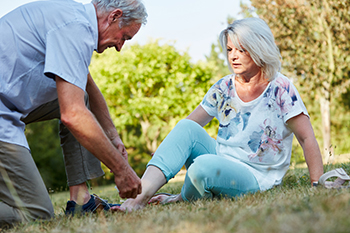
Most people experience some form of foot pain in the course of their lives. A trip to the chiropodist often leads to treatment that works to ease the pain. But in certain cases, foot pain can indicate a deeper medical problem, the main examples of which are arterial disease, arthritis, and diabetes. Millions of people develop peripheral artery disease, or PAD, as plaque builds up in the walls of their blood vessels. This constricts the flow of blood to the lower extremities and can seriously affect the feet. High blood pressure, cholesterol, and overuse of alcohol and tobacco are contributors to PAD, increasing the risk of heart attacks and strokes. Rheumatoid arthritis, or RA, also may lead to pain that begins in the toes and spreads to the feet and ankles. Joint damage caused by RA can change the shape of the feet and present other problems. Numbness and tingling in the toes and feet may be the result of diabetes, caused by high levels of sugar in the blood. Damage to the nerves that serve the feet can result in the inability to feel pain or notice cuts and sores on the feet. If these are ignored, they can become ulcerated and put one at risk for other serious problems. For help, it is suggested that you consult a chiropodist who is trained to deal with these foot-related conditions.
Foot pain can have many causes. To receive an accurate diagnosis and treatment for your foot pain, please consult with one of the chiropodists from The Footcare Centre. Our chiropodists will assess your condition and provide you with quality foot and ankle treatment.
Causes
There are a variety of different conditions that can cause foot pain, including:
Plantar fasciitis
Deformities, such as bunions or hammertoes
Injuries to the muscles, bones, tendons, or ligaments in the feet
Arthritis
Flat feet
Ingrown toenails
Symptoms
The type and location of your foot pain can help determine what may be causing it and what type of treatment options are best for you.
Common types of foot pain include:
Heel pain
Arch pain
Toe pain
Ball of foot pain
Pain that has a stabbing, burning, or tingling quality
Pain that is constant, intermittent, or that gets better or worse depending on the situation
Diagnosis
A thorough medical history and physical examination of your feet will be required to determine a diagnosis. Imaging studies, such as X-rays or MRIs may be performed to rule out or confirm certain diagnoses.
Treatment
Treatment will depend on the cause of the pain. Common treatments for foot pain include resting, icing, compressing, and elevating the affected foot, wearing orthotics, or taking anti-inflammatory medications.
If you have any questions, please feel free to contact our office located in . We offer the newest diagnostic and treatment technologies for all your foot care needs.
Foot Pain
Foot pain is a common symptom of a large variety of injuries and medical conditions. A diagnosis can be narrowed down by describing the locations and type of pain that you are experiencing.
Pain in the heel is often caused by plantar fasciitis, an inflammation of the ligament that runs along the bottom of the foot and connects the heel to the toes. Plantar fasciitis usually causes stabbing heel pains and the pain is at its worst upon arising in the morning or when taking your first steps after a long period of rest. Heel pain can also be caused by heel spurs, bruises on the fat pad of the heel, or heel fractures.
Pain in the ball of the foot can be caused by Morton’s neuroma, in which the tissue of the nerves between the bases of the toes become thickened, causing tingling and numbness. Other causes of pain in the ball of the foot include metatarsalgia or sesamoiditis.
Pain in the arch of the foot can be caused by plantar fasciitis or having flat feet or fallen arches. Pain in the toes can be caused by many conditions, including gout, bunions, hammertoes, ingrown toenails, toe sprains or fractures, arthritis, and corns.
To find out what is causing your foot pain, it is recommended that you consult with a chiropodist, who can diagnose your condition and offer the appropriate treatments.
Different Types of Running Shoes
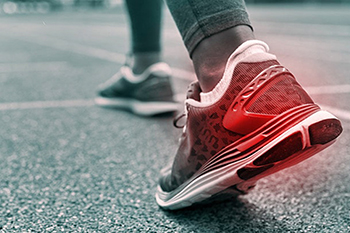
Choosing the right running shoe is essential for improving performance and preventing injuries while running. But this is not necessarily easy to do because a number of factors must be considered before making a purchase. Among these are running surfaces, gait or foot biomechanics, weight, and performance goals. Running shoes fall into five classifications to fit your specific needs. For instance, if you are a sprinter, lightweight shoes are a good choice. On the other end of the spectrum, a trail runner benefits from shoes that offer more support, stability, and protection. Stability shoes are a good choice for runners with few arch or pronation issues because they offer ample arch cushioning and support. Motion control shoes are helpful to runners who overpronate, as they are rigid and have a wider sole. Finally, cushioned shoes offer shock absorption features designed to account for supination problems. For help with determining which running shoe is best for your feet, it is suggested that you consult a chiropodist.
The right running shoes can sometimes be difficult to find. With so many options on the market, it’s important to know the unique needs of your feet prior to buying running shoes. If you require assistance, please consult with one of the chiropodists from The Footcare Centre. Our chiropodists can help you maintain the health of your lower limbs and your mobility.
When looking for running shoes, take into consideration:
The type of running you will be doing
The terrain you plan to run on
Your gait or running pattern
Your arch type
Other unique foot needs
A chiropodist can help by examining your feet and your gait to determine what types of shoes may be best for you. Some runners may require motion control shoes, which prevent your foot from rolling too far inward while you run. Others may need stability shoes, which offer more balance, cushioning, and support. When shopping for shoes, make sure that they are the right size, fit comfortably, and are made of breathable materials.
If you have any questions, please feel free to contact our office located in . We offer the newest diagnostic and treatment technologies for all your foot care needs.
